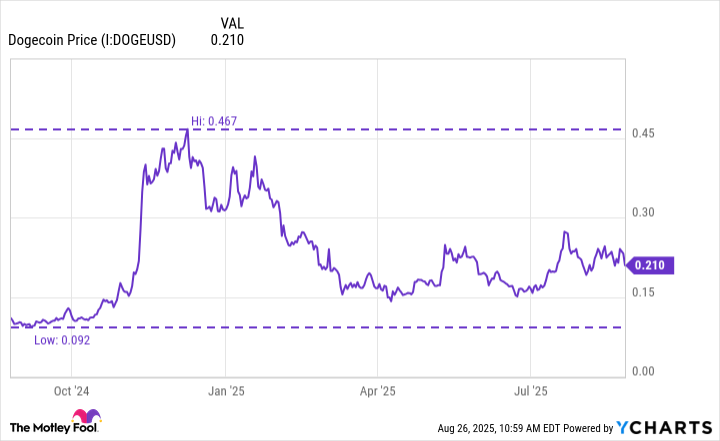Investing in cryptocurrency isn't for the faint of heart. Unlike buying stock, which gives you ownership in a real business, crypto is a speculative bet on digital assets and the rise of decentralized finance (DeFi). In a world where traditional fiat currency faces growing skepticism, crypto offers the allure of innovation -- but with volatility at its core.
During the last decade, the idea of cryptocurrency as a legitimate asset class has gained traction, yet mainstream adoption remains a work in progress. Today, the most widely recognized coins include Bitcoin, Ethereum, Solana, Cardano, and XRP. Still, not every investor is content with the blue chip equivalents of crypto. Just as in the stock market, some seek out higher-risk opportunities.
In crypto, those opportunities take the form of meme coins -- tokens that thrive on internet culture, viral hype, and social media buzz. Two of the most famous contenders among meme coins are Dogecoin (DOGE +1.07%) and Shiba Inu (SHIB +4.04%). Although both are highly speculative, one is emerging as the more resilient and potentially more rewarding opportunity.
Let's break down the key differences between Dogecoin and Shiba Inu to help investors decide which meme coin might be worth a roll of the dice.

CRYPTO: DOGE
Key Data Points
Taking a look at Dogecoin
Dogecoin investors have been on quite the rollercoaster ride during the past year. At its current price of about $0.21, Dogecoin is essentially right in between its 52-week high and low. The most dramatic swing occurred last November.
Dogecoin Price data by YCharts.
During then-candidate Donald Trump's U.S. election campaign, he frequently voiced concerns about the growing national debt. That narrative caught the attention of none other than Tesla Chief Executive Officer Elon Musk -- a Dogecoin fan who has previously branded himself as "The Dogefather."
Shortly after Trump's election victory, the president-elect assembled a task force aimed at identifying areas of potential wasteful government spending. Musk oversaw this initiative, which was dubbed the Department of Government Efficiency (DOGE).
The acronym alone was enough to fuel rampant speculation across online crypto forums that Dogecoin would play a role in government strategy. The hype ignited a sharp rally, during which Dogecoin's price rose by nearly fivefold.
However, the euphoria came to a halt after Musk himself said that the U.S. government had "no plans" to use Dogecoin as part of its broader crypto exploration strategy or in any other capacity.
As the chart shows, Dogecoin's price has been stuck in a tight range for nearly a year, unable to reignite the speculative frenzy that fueled its brief yet explosive rally.
Taking a look at Shiba Inu
On the surface, Shiba Inu and Dogecoin look almost identical. Both fall under the category of meme coins, and both are branded with a playful dog mascot, which played a role in their viral popularity. But beneath the surface, Shiba Inu has done a lot to carve out its own unique identity.
Developers have worked to incorporate real-world utility into Shiba Inu's ecosystem. Its decentralized exchange (DEX), ShibaSwap, lets investors stake their tokens for rewards, trade assets, and engage with other users -- particularly in the metaverse.
Yet even with these advancements, Shiba Inu can't solve its biggest drawback: supply. With nearly 600 trillion tokens in circulation, Shiba Inu trades for just fractions of a penny.
For the token to reach even just $1, it would require enormous amounts of coin burning that takes permanently reduce the supply -- a scenario that is highly unlikely given the limited size of Shiba Inu's investor base and overall appeal.

Image source: Getty Images.
The verdict
Between the two, Shiba Inu looks like the stronger contender. Dogecoin may enjoy recognition as a payment method in certain circles, but its utility is limited in comparison to Shiba Inu's diversified ecosystem.
That said, investing in Shiba Inu comes with notable challenges. The enormous supply makes meaningful price appreciation almost to impossible, and its reputation as an altcoin to Dogecoin further limits its appeal. My intuition is that many investors remain unaware of Shiba Inu's applications -- meaning it is likely to remain as a niche opportunity as opposed to a mainstream asset.
Although Shiba Inu may be the better bet relative to Dogecoin, I wouldn't entertain the idea of investing in it. Shiba Inu still remains a largely speculative opportunity, and it may never reach its full price potential, given its structural headwinds.
At the end of the day, both tokens are best viewed as gambles and not serious choices for prudent long-term investors.
